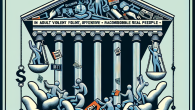
Long-Term Interest Rates and Their Relationship With Demographics
The Invisible Handshake: How Central Banks Shape Global Markets Behind the Curtain
Ah, central banks — the unsung choreographers of our economic ballet. While the average investor browses stock tickers or obsesses over Bitcoin’s latest tantrum, the real performance is being meticulously orchestrated by folks in suits, armed not with flamethrowers like market bears, but far more dangerous weapons: interest rates, monetary policy statements, and economic projections.
This article invites you behind the curtain of polite press conferences and policy jargon to explore how institutions like the Federal Reserve, ECB, Bank of Japan, and others dance delicately — or stomp — across the global stage.
Understanding the Tools of the Trade
Interest Rates: The Central Bank’s Steering Wheel
The most recognizable lever in a central banker’s toolkit is the benchmark interest rate. Lower it, and the economy accelerates; raise it, and things can come to a screeching halt. This dance between stimulus and moderation is less art, more chess match — one that impacts every credit card bill and mortgage payment on Earth.
Consider the United States Federal Reserve. When inflation rears its ugly head — perhaps driven by supply chain disruptions, excess liquidity (hello, pandemic stimulus!), or surging demand — the Fed tightens the screws. Raising the federal funds rate effectively increases borrowing costs, taming inflationary pressured demand.
Quantitative Easing and Tightening: Manipulating the Flow
Beyond interest rates, central banks deploy quantitative easing (QE) to inject liquidity into the system — often through large-scale asset purchases like government bonds.
But when the economy overheats or inflation breaches acceptable boundaries (typically a neat and tidy 2%), central banks reverse course into quantitative tightening (QT), offloading assets and pulling excess money from circulation — a courteous way of drying out the punch bowl before the party turns into a riot.
Forward Guidance: Signaling Without Saying
Subtlety, thy name is forward guidance. In lieu of jolting markets with policy surprises, central banks often use press releases or Q&A sessions to telegraph future actions. Investors, fund managers, and macroeconomists hang on every word — decoding whether “retaining current policy” means a dovish pause or a hawkish positioning phase.
How Global Markets React
Capital Flow Volatility
One of the immediate effects of central banking policy, especially from the Federal Reserve, is capital reallocation. When U.S. rates rise, for instance, global investors may sell emerging market equities and bonds to flock toward safer, higher-yielding American assets.
This domino effect can:
- Lead to currency devaluations in emerging markets
- Pressure their central banks to raise rates (even when ill-suited for their economies)
- Trigger inflation via imported goods becoming costlier
Currency Markets and Rate Differentials
Currencies are especially sensitive to interest rate announcements. If the ECB lifts its rates while the Bank of Japan stands pat, capital often flows toward European assets, strengthening the euro while the yen limps along sadly in the corner.
Forex traders, meanwhile, engage in the ubiquitous “carry trade,” borrowing in low-rate currencies to invest in higher-yielding assets. A global rate hike cycle can crush such trades, which adds even more volatility.
Equities and the Liquidity Narrative
When central banks are pumping money into the system, equities tend to ascend — not necessarily because earnings improve, but because there’s simply more money chasing a fixed number of investment opportunities.
But when the liquidity narrative vanishes (a.k.a. rates go up and QE tapers), even fundamentally strong companies can suffer as valuations tighten, earnings are discounted more heavily, and the cost of capital rises.
The Global Chessboard: Interdependence in Action
The Federal Reserve’s Gravity
Let’s not mince words here — the Federal Reserve has the gravitational pull of a moon-sized financial black hole. When it sneezes, other central banks scramble for tissues.
For example, if the Fed aggressively hikes rates to combat U.S. inflation, it can exert pressure globally:
- By strengthening the dollar, thereby increasing the repayment cost of dollar-denominated debt worldwide.
- By draining capital from emerging economies as investors chase higher yields in dollar assets.
- By forcing other central banks to raise their own rates or risk currency depreciation and domestic inflation.
The Spillover Effect
The Bank of England and the ECB must carefully calibrate their responses. Raise rates too quickly, and they risk stifling economic recovery. Move too slowly, and their currencies falter while inflation prints keep the public fuming at grocery store receipts.
In regions like Southeast Asia or Latin America, even minor Fed adjustments have substantial consequences. A quarter-point hike in the U.S. can lead to dramatic adjustments in capital flows, exchange rates, and borrowing benchmarks for governments and corporations alike.
The Unseen Risks: When Central Banks Misstep
Communication Breakdown
If forward guidance is misread or unclear, markets can overreact. Consider the “Taper Tantrum” of 2013, when an offhand mention of potential QE tapering by Fed Chair Ben Bernanke sent bond yields soaring and emerging markets tumbling.
Policy Lag and Overcorrection
Monetary policy operates with a delay. A rate hike today may not fully reverberate through the economy for 6 to 12 months. This invites the risk of central banks overcompensating — hiking too far too fast, only to later trigger a recession they then scramble to fix.
External Shocks
No central bank operates in a vacuum. A geopolitical event (say, a war or pandemic), financial contagion (ahem, subprime crisis), or even a major commodity price swing can derail bank projections and render policy tools ineffective in the short term.
Closing Thoughts: Controlled Chaos or Mastered Symphony?
Central banks may not always get it right — but make no mistake, they are the ultimate puppet masters behind the market marionettes. Their decisions reverberate through debt markets, equity indices, exchange rates, and even the price of your morning cappuccino.
Understanding how these monetary titans think, plan, and occasionally fumble is essential for any global investor, economist, or even the curious citizen simply wondering why their savings account still pays them less than a cup of coffee per year.
And so, whether you’re charting economic forecasts, reallocating portfolios, or merely seeking to decipher the next enigmatic press release from Jerome Powell — remember:
The most important market movements often begin with a whisper in a well-lit press room, not a scream on the trading floor.
Need help navigating the signals behind the suits? Contact us or learn more about who we are.









Leave a Reply